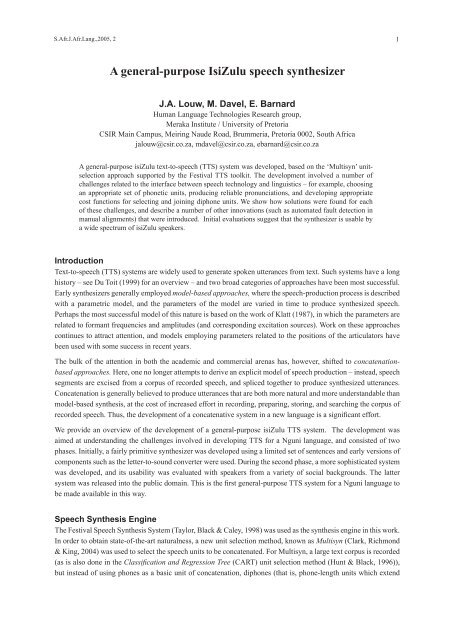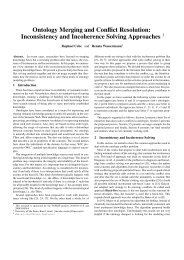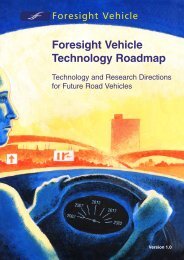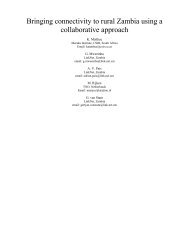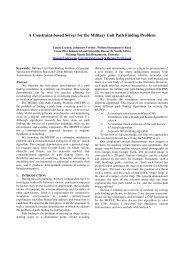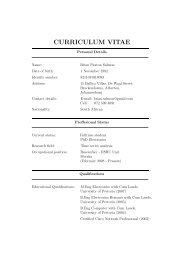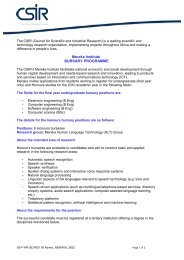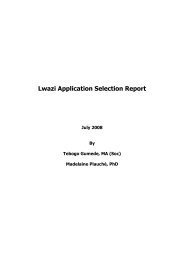A general-purpose IsiZulu speech synthesizer - CiteSeerX
A general-purpose IsiZulu speech synthesizer - CiteSeerX
A general-purpose IsiZulu speech synthesizer - CiteSeerX
Create successful ePaper yourself
Turn your PDF publications into a flip-book with our unique Google optimized e-Paper software.
S.Afr.J.Afr.Lang.,2005, 21A <strong>general</strong>-<strong>purpose</strong> <strong>IsiZulu</strong> <strong>speech</strong> <strong>synthesizer</strong>J.A. Louw, M. Davel, E. BarnardHuman Language Technologies Research group,Meraka Institute / University of PretoriaCSIR Main Campus, Meiring Naude Road, Brummeria, Pretoria 0002, South Africajalouw@csir.co.za, mdavel@csir.co.za, ebarnard@csir.co.zaA <strong>general</strong>-<strong>purpose</strong> isiZulu text-to-<strong>speech</strong> (TTS) system was developed, based on the ‘Multisyn’ unitselectionapproach supported by the Festival TTS toolkit. The development involved a number ofchallenges related to the interface between <strong>speech</strong> technology and linguistics – for example, choosingan appropriate set of phonetic units, producing reliable pronunciations, and developing appropriatecost functions for selecting and joining diphone units. We show how solutions were found for eachof these challenges, and describe a number of other innovations (such as automated fault detection inmanual alignments) that were introduced. Initial evaluations suggest that the <strong>synthesizer</strong> is usable bya wide spectrum of isiZulu speakers.IntroductionText-to-<strong>speech</strong> (TTS) systems are widely used to generate spoken utterances from text. Such systems have a longhistory – see Du Toit (1999) for an overview – and two broad categories of approaches have been most successful.Early <strong>synthesizer</strong>s <strong>general</strong>ly employed model-based approaches, where the <strong>speech</strong>-production process is describedwith a parametric model, and the parameters of the model are varied in time to produce synthesized <strong>speech</strong>.Perhaps the most successful model of this nature is based on the work of Klatt (1987), in which the parameters arerelated to formant frequencies and amplitudes (and corresponding excitation sources). Work on these approachescontinues to attract attention, and models employing parameters related to the positions of the articulators havebeen used with some success in recent years.The bulk of the attention in both the academic and commercial arenas has, however, shifted to concatenationbasedapproaches. Here, one no longer attempts to derive an explicit model of <strong>speech</strong> production – instead, <strong>speech</strong>segments are excised from a corpus of recorded <strong>speech</strong>, and spliced together to produce synthesized utterances.Concatenation is <strong>general</strong>ly believed to produce utterances that are both more natural and more understandable thanmodel-based synthesis, at the cost of increased effort in recording, preparing, storing, and searching the corpus ofrecorded <strong>speech</strong>. Thus, the development of a concatenative system in a new language is a significant effort.We provide an overview of the development of a <strong>general</strong>-<strong>purpose</strong> isiZulu TTS system. The development wasaimed at understanding the challenges involved in developing TTS for a Nguni language, and consisted of twophases. Initially, a fairly primitive <strong>synthesizer</strong> was developed using a limited set of sentences and early versions ofcomponents such as the letter-to-sound converter were used. During the second phase, a more sophisticated systemwas developed, and its usability was evaluated with speakers from a variety of social backgrounds. The lattersystem was released into the public domain. This is the first <strong>general</strong>-<strong>purpose</strong> TTS system for a Nguni language tobe made available in this way.Speech Synthesis EngineThe Festival Speech Synthesis System (Taylor, Black & Caley, 1998) was used as the synthesis engine in this work.In order to obtain state-of-the-art naturalness, a new unit selection method, known as Multisyn (Clark, Richmond& King, 2004) was used to select the <strong>speech</strong> units to be concatenated. For Multisyn, a large text corpus is recorded(as is also done in the Classification and Regression Tree (CART) unit selection method (Hunt & Black, 1996)),but instead of using phones as a basic unit of concatenation, diphones (that is, phone-length units which extend
2 S.Afr.J.Afr.Lang.,2005, 2from the temporal centre of one phone to the centre of the adjacent phone) are used. This, together with the factthat all diphones are searched for possible candidates, potentially occurring as strings of adjacent diphones in thetarget data, produces superior synthesis quality when compared to other concatenative synthesis methods.The database consists of multiple instances of each diphone type whereas a diphone <strong>synthesizer</strong> consists of adatabase with just one instance of each diphone type. Thus, no prosodic modifications, which introduce deteriorationin <strong>speech</strong> quality, are performed on the selected units. It is assumed that the selected units will contain the correctprosody, based on their context.The total cost of selecting a candidate diphone is the sum of the target and concatenation costs. Target costs arelinguistic measures of how well the candidate diphone fits the target diphone, while the concatenation cost is theacoustic cost of concatenating a candidate diphone with other possible candidates in the target string.The advantages of the Multisyn <strong>synthesizer</strong> over the more conventional Cluster unit selection method is that thetarget costs can be chosen to optimize the quality of the synthesized <strong>speech</strong>. These costs <strong>general</strong>ly depend on thecharacteristics of the language being synthesized, and are difficult to train from data, especially if the databaseis relatively small (fewer than 500 utterances). Another advantage is the fact that all units are candidates forselection, whereas in the Cluster unit selection the search space for possible candidates is broken up into clustersof acoustically similar units having the same target costs; thus, the selected units may not be optimal in that case.The disadvantages of the Multisyn <strong>synthesizer</strong> are related to its strengths: a large search space must be searched,and target costs are calculated during synthesis (whereas with the Cluster unit selection method the target costs areinherently the clusters themselves, and the clustering process significantly reduces the extent of the search space).Multisyn synthesis may therefore be slower.Task domain and text corpus collectionA ‘weather-related’ task domain was chosen for our initial development – this is attractive since the dynamicnature of weather-based information demonstrates the ability of TTS (over the use of voice recordings). Thesystem developed is nevertheless a <strong>general</strong>-<strong>purpose</strong> text-to-<strong>speech</strong> system, with performance optimized for thespecific task domain. That is, the system can pronounce any isiZulu text, but more than half of the recordedutterances were drawn from the weather domain, thus producing somewhat better synthesis in this domain.A previously prepared isiZulu text corpus was not available for this development. In order to collect such a corpus,information was drawn from different sources. A <strong>general</strong> domain text corpus of 30,000 words was collected fromthe Internet. This corpus consists mainly of government-oriented documents, relating to domains such as health,tourism and governance. The documents were processed, and official approval was obtained where copyrightrestrictions were a concern. A first-language isiZulu speaker, who ensured that only valid isiZulu sentences wereincluded, validated the corpus. The corpus was further extended with a number of customized weather-specificsources (such as transcriptions of televised weather reports, and manually developed texts).An open-source text selection tool, Optimal Text Selection (OTS), (developed at HP Labs in Hyderabad, India – seeTaludkar, 2004), was used to choose phonetically balanced sentences. Specifically, the smallest set of sentencesthat provide coverage of all diphones in the corpus, without regard for their context, was selected. A subset of 153sentences was thus selected for recording. After the completion of an early version of the system, an additional 27sentences were added to compensate for missing diphones and frequently occurring English loan words.Phone set definition and grapheme-to-phoneme rulesAn initial phone set was defined, originally based on the phone set defined in standard texts on isiZulu. For example,Poulos and Msimang (1998) define 74 phones to describe the sound system of isiZulu, but several of these areclusters (for example [mv] in imvula ‘rain’), which can be viewed as a concatenation of constituent sounds forthe <strong>purpose</strong>s of concatenative synthesis. In addition, the 18 click sounds listed in Poulos and Msimang (1998) can
S.Afr.J.Afr.Lang.,2005, 25Intonation and duration modelling<strong>IsiZulu</strong> is considered to be a tone language (although there is some debate on the meaning of this classificationwhen applied to the Nguni family of languages (Roux, 2000)). We therefore expected that accurate production ofappropriate pitch contours would be an important element of an understandable system.After analysis of the salient intonation patterns produced by an isiZulu speaker producing continuous sentences, itbecame clear that tone production in natural isiZulu <strong>speech</strong> is less predictable from syntactic considerations thanin a language such as Ibibio (Gibbon, 2002). In particular, in isiZulu semantic and pragmatic factors combine withsyntactic variables in ways that are not well understood.Accurate prediction of the words to mark in this way is beyond our current capabilities, and the consensus ofboth isiZulu speakers and system developers was that treating all words as ‘unmarked’ would produce moreunderstandable <strong>speech</strong>. Further linguistic features such as syllabic stress and boundary tones were similarly notexplicitly conveyed.Although the resulting system is therefore ‘tone deaf’, this fact does not particularly bother isiZulu speakers – forexample, one listener simply commented that ‘this speaker comes from a different region’. This lends supportto the description of isiZulu as a pitch-accent language, a point of view that is not universally accepted (Roux,2000). Nevertheless, we believe that we can improve the quality of synthesis substantially by more sophisticatedmodeling of the pitch accents. Of course, the eventual aim is to produce ‘natural’ tones, but that would require thedevelopment of an algorithm to predict which words are to be marked (and, of course, to predict the appropriateintonation of those words). These tasks are currently under investigation (Kuun, Zimu, Barnard & Davel, 2005).Analysis of the same recordings, as well as discussions with isiZulu linguists and other isiZulu speakers, indicatedthat the placement of short pauses (100 – 150 ms each) between each pair of (conjunctively written) wordswould sound acceptably normal – thus, part-of-<strong>speech</strong> (POS) determination was not necessary for the <strong>purpose</strong>sof chunking for synthesis. Although this approach does reduce the naturalness of the synthesized <strong>speech</strong>, thisimpairment is not severe, in light of the agglutinative nature of isiZulu, together with the strong tendency to reducethe ultimate syllable of each word.Regarding duration, both linguistic knowledge and informal measurements point to the lengthening of thepenultimate syllable of each word as the most salient effect. We have therefore not implemented an explicitduration model, but weigh the syllable position (that is, the number of syllables between the current syllable andthe end of the word) heavily in the calculation of the target costs during synthesis. Again, listeners find this to bean acceptable compromise.Development of appropriate target-cost functionTo select appropriate units during synthesis, a concatenative <strong>synthesizer</strong> combines a target cost and a join cost. Thetarget cost is the sum of a user-definable set of weighted components, each of which adds a penalty cost if somelinguistic feature of the candidate diphone does not match the target, or if some default penalty feature is set in acandidate (which can be used to penalise candidates with poor labelling or bad pitch marking). To be precise, thesecosts refer to features which are defined for the individual phones that constitute the diphone; hence, the left andright halves of a diphone will typically have different feature values.We have developed a number of components, which are appropriate for isiZulu and related languages. Theweightings for the current target costs have been derived empirically to provide a baseline acceptable performance,but these can easily be changed to values based on statistical training or perceptual evaluation, should data beavailable. The costs that were found to have a significant influence on the quality of the unit selection were:
6 S.Afr.J.Afr.Lang.,2005, 21. Word syllable positions:Two syllable positions were found to have a particular influence on <strong>speech</strong> quality: the final syllable in a word(see above) and the penultimate syllable. Thus, a candidate unit’s syllable position is compared to the target,counting from the end of the word. If a mismatch occurs, a penalty weight of 8 is added.2. Number of syllables in word:It was found that if a candidate unit is extracted from a word where the number of syllables differs significantlyfrom that of the target word then a perceptual mismatch occurs, since the speed of production correlates withthe number of syllables in a word. A weight of 3 is added if the number of syllables in the target word andcandidate word differ by more than a factor of 1.5.3. Left and right contexts:The neighbours to the left and to the right of the candidate and target units are compared. For example, in theword ‘test’, preceding the diphone ‘e-s’ with a diphone ‘t-e’ produces no penalty, while the preceding diphones‘w-e’ or ‘b-e’ would trigger this penalty. If a mismatch occurs a weight factor of 3 is added to the unit’s targetcost.Pilot evaluationA pilot evaluation was designed in order to determine the usability of the current version of the isiZulu TTS system.In particular, we wanted to determine whether the TTS would be understandable to users with limited literacy andlimited exposure to such technology.One part of the pilot evaluation was designed to assess the utility of our TTS system for over-the-telephone use.Note that this is a stringent test, since the low bandwidth in itself compromises intelligibility. Information onthree subjects (a weather forecast, the disease malaria, and unemployment insurance) was scripted in English,translated into isiZulu, and synthesized with our TTS system. This information was embedded in an InteractiveVoice Response (IVR) application, which provided initial instructions, and then prompted the evaluators to listento each of the information clips. All prompts are in isiZulu; whereas the synthesized voice is male, a female voicewas recorded for the rest of the IVR application.A questionnaire was prepared to (a) obtain biographic information of the evaluators (e.g. their age, home language,level of education); (b) test the evaluators’ understanding of the matter presented in this way; and (c) query theevaluators’ subjective experience of the synthesized <strong>speech</strong>. Evaluators were asked to provide their biographicinformation before interacting with the IVR application; understanding was tested after each information clip hadbeen presented, and the questions on their subjective experiences were completed after termination of the IVRapplication. All responses were recorded on paper – where the evaluators were not sufficiently literate to performthis task, an experimenter asked them the questions verbally, and filled out the questionnaire on their behalf.Finally, a Web-based evaluation was also developed in order to gain access to a wider group of evaluators (althoughthis part of the evaluation would then be limited to literate, technologically sophisticated users). The same basicprotocol was followed as for the telephone-based evaluation, but users now recorded their responses directly in theWeb application, and their responses were logged on the Web server. (For practical reasons, this system was madeavailable on an intranet, rather than the public Internet.)Evaluators were canvassed in various ways, ranging from personal contacts to a company-wide e-mail solicitation.Evaluators completed the process without assistance where possible, but in cases where their level of literacy didnot allow them to read the instructions and complete the questionnaire, an experimenter assisted them by readingfrom the questionnaire and entering their answers on the paper form. Results from the telephone-based and Webbasedtrials were entered into a spreadsheet, and processed to assess the performance of the TTS system.The current system is domain-independent, but with a bias towards the weather domain; the evaluation allowed usto assess how strongly this bias influences the quality of the synthesized utterances.
S.Afr.J.Afr.Lang.,2005, 27ResultsA test user group consisting of twenty-three people evaluated the telephony system. 40% of the test group (E1)had a low literacy level. These evaluators either indicated that they could not read or write, or had significantdifficulty reading the evaluation form. These users were typically employed as labourers, gardeners or laundryworkers.The remaining 60% of the test group (E0) were literate, and in certain cases well educated. Occupationsfor this second group ranged from domestic worker and security guard to software developer and human resourcespractitioner. Sixteen of the telephony evaluators indicated that they spoke isiZulu as a ‘home language’ – theremainder of the test group consisted of fluent isiZulu speakers with home languages that included Setswana,isiNdebele, SiSwati, Xitsonga and isiXhosa. (Fluency was assessed by the subjects themselves, and not subjectedto further verification.)E0 EvaluationThe following was noted during the E0 evaluation (literate evaluators):• 57% of evaluators indicated that they found the synthesized voice ‘fairly easy’ to ‘very easy’ to understand.While the remainder of the test group found it ‘fairly hard’ to ‘very hard’, no one indicated that the system was‘impossible’ to understand.• Surprisingly, 50% of the evaluators found the synthesized voice ‘as natural’ as or only ‘slightly less natural’than the recorded prompts used to provide the instructions. The remainder felt that the voice was either ‘a fairamount’ or ‘a lot’ more unnatural with only one evaluator indicating that the synthesized voice does not ‘soundhuman at all’.• A strong correlation was observed between people’s ability to answer the test questions correctly, and the‘intelligibility score’ they gave the system, as shown in Table 1.• Five of the 13 evaluators (36%) answered all three questions correctly. The average number of correct answersover all evaluators was 2.1 (of 3).• Home language isiZulu-speakers tended to answer the evaluation questions more accurately than other isiZuluspeakers(with an average of 2.3 correct answers compared to 1.8).Table 1: Perception of intelligibility according to number of questions answered correctly for E0evaluatorsNumber of correct answers Own intelligibility score(of 3) (of 5)3 4.42 3.31 2.7E1 EvaluationThe E1 evaluation (illiterate evaluators) produced results that differed from the above in interesting ways. Duringobservation and through after-evaluation discussions, it became clear that the test procedure was not sufficient intwo ways:• When responding to evaluation questions, evaluators found it difficult to differentiate between informationobtained from the system, and information they knew beforehand. For example, the weather questionprovided a fictional weather report and on account of the information provided, asked what the weather
8 S.Afr.J.Afr.Lang.,2005, 2is ‘expected to be today’. A number of the evaluators provided the actual information, not the fictionalinformation 1 .• Evaluators found it difficult to choose a negative answer – even where they knew the negative answerto be correct. For example, while evaluator E106 answered the malaria question incorrectly, it becameclear from the post-evaluation discussion that he actually did understand the message clearly. However,since he understood contact with human blood to be the way in which the mosquito contracted malaria(information provided by the TTS system), and saw that is ‘bad’, he chose the other (incorrect) answer.In the same vein, the employment related question asked whether ‘only an employer’ should contributeto the Unemployment Insurance Fund. Even evaluators, who in subsequent questioning indicated thatthey understood that both the employer and employee should pay, still chose ‘yes’ because the employershould contribute, rather than ‘no’ (the correct answer) since the double negative required to answer thequestion correctly was unnatural to them.This demonstrates the complexity involved when using a comprehension test with low literacy evaluators: an areain which significant further research is required.The subjective opinions of E1 evaluators were similar to those of E0 evaluators with regard to intelligibility(3.8 average compared to 3.6) and slightly lower with regard to naturalness (2.8 average compared to 3.2).While the comprehension test (which does not compensate for the issues mentioned above) indicates a low levelof intelligibility (1.4 average), the results of the subjective evaluation are very encouraging. In light of thesecomplications, detailed results of the objective evaluation are not included here.ConclusionInitial experiments with the isiZulu test system have produced encouraging results. The voice was found to be quiteunderstandable by the majority of evaluators – both those with high levels of literacy and those with limited or noliteracy. Since much of the information was outside the weather domain, which was the focus of this development,it is safe to consider this as a domain-independent result. (In fact, comprehension was best in the non-weatherdomains, for reasons described above.)Clear room for improvement remains, both in terms of the characteristics of the TTS system, and in our evaluationthereof. The design of comprehension tests for users of limited literacy will require particular attention. Interestingly,the lack of attention to prosodic information did not attract any specific comments from the evaluators, suggestingthat this may not be as important for understandable isiZulu TTS as had been believed. The lessons learnt will beapplied in refining our experimental approach, and in the continued development of the isiZulu TTS system.Notes1 The fact that 8 of the 9 E1 evaluators chose ‘sunny’ rather than ‘cloudy’ (the correct answer) testifies ofprevalent weather conditions in Gauteng during late winter.ReferencesClark, R.A.J., Richmond, K. & King, S. 2004. Festival 2: build your own <strong>general</strong> <strong>purpose</strong> unit selection <strong>speech</strong>synthesiser. Proceedings of the 5th ISCA Speech Synthesis Workshop. Pittsburgh, PA:173–178.Davel, M. & Barnard, E. 2004. The effficient generation of pronunciation dictionaries: Machine learning factorsduring bootstrapping. Proceedings of the 8th International Conference on Spoken Language Processing.Korea:2781–2784.Du Toit, T. 1999. An introduction to text-to-<strong>speech</strong> synthesis. Berlin:Springer.Gibbon, D. 2002. Typology of African prosodic systems, in Occasional Papers in Typology 1, edited by U. Gut &D. Gibbon. Bielefeld: Bielefeld. Occasional Papers in Typology 1.


